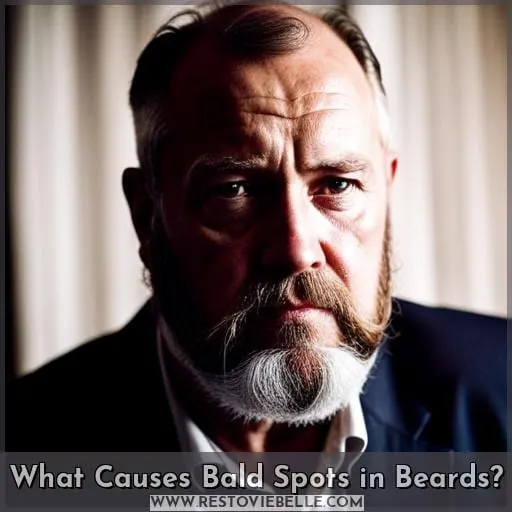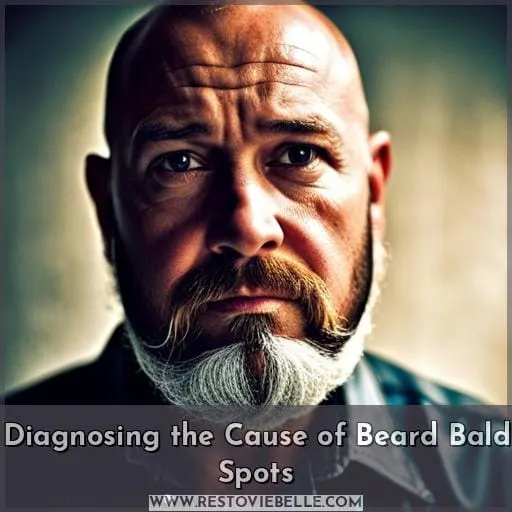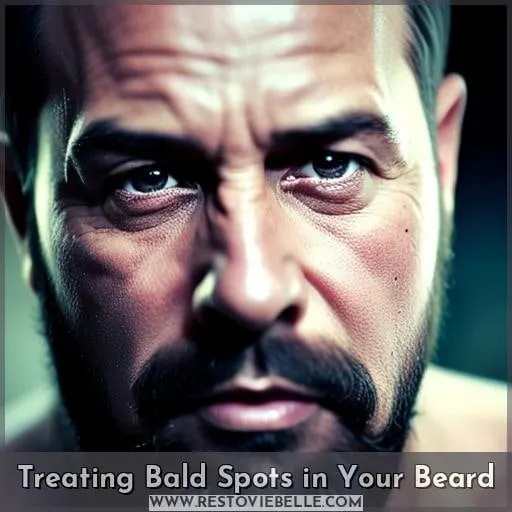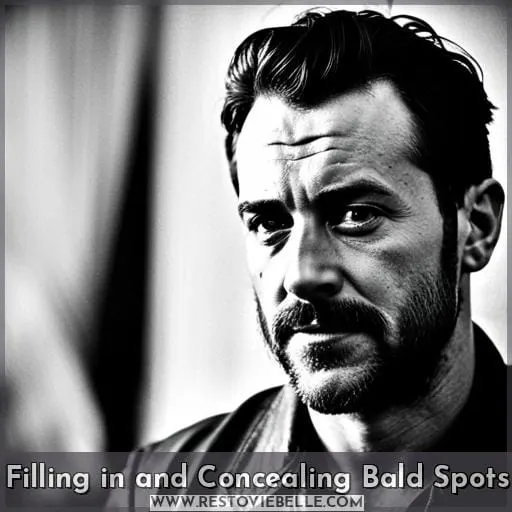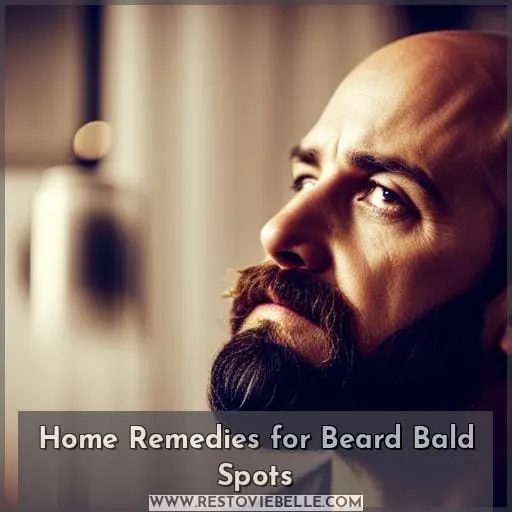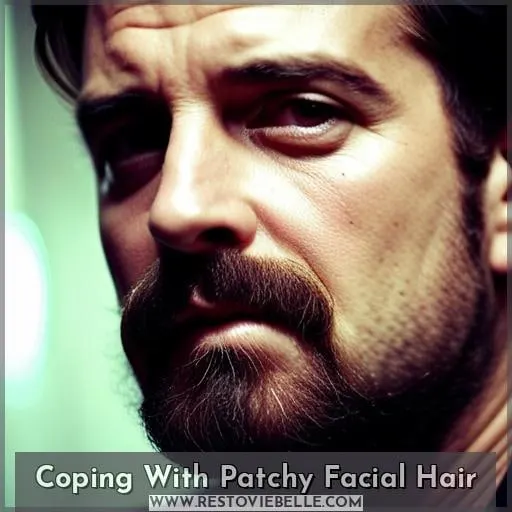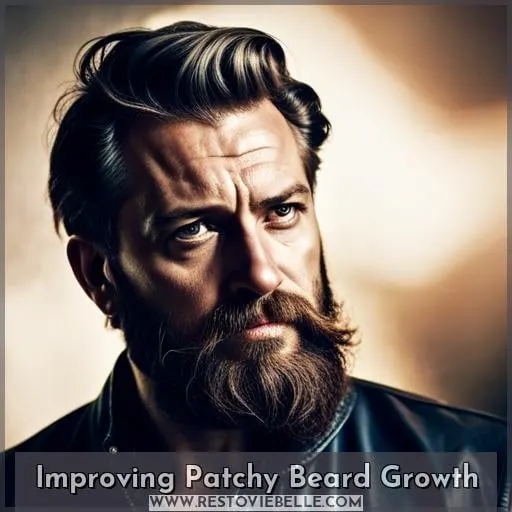This site is supported by our readers. We may earn a commission, at no cost to you, if you purchase through links.
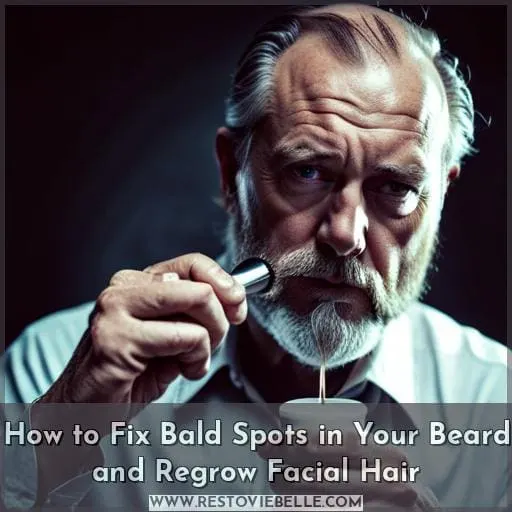 You’ve noticed some bald spots in your beard and aren’t sure what to do. Don’t worry, this is a common issue that can be fixed with the right techniques.
You’ve noticed some bald spots in your beard and aren’t sure what to do. Don’t worry, this is a common issue that can be fixed with the right techniques.
The most likely causes are alopecia barbae, a skin condition causing hair loss, or a lack of natural hair growth related to hormones.
First, we’ll evaluate what’s causing those pesky bald spots.
Then, we can treat the root cause, whether with medications, supplements, or lifestyle changes.
If the spots still bother you, you’ve got options like using makeup to conceal patches or even beard transplants for permanent results.
With a customized approach tailored to your unique situation, it is possible to fill in and regrow hair in those bald spots.
Soon you’ll be rocking a full, healthy-looking beard.
Table Of Contents
Key Takeaways
- See a dermatologist to diagnose the cause and get prescription treatments like steroids or antifungals if necessary.
- Reduce stress levels and improve sleep habits and diet to support healthy hair growth.
- Use beard grooming techniques like brushing and combing to make patches less noticeable.
- Gently massage beard oil into bald spots at night to stimulate the hair follicles.
What Causes Bald Spots in Beards?
You may notice isolated patches of thin or missing beard hair called bald spots. These circular depressions have distinct causes, including the autoimmune disease alopecia barbae and factors such as medication side effects, poor nutrition, and stress.
Bald spots in beards can be caused by a variety of factors. The autoimmune disease alopecia areata, which results in hair loss on the scalp or body, can also cause bald patches in a beard. Certain medications may also lead to hair thinning or loss as a side effect. Inadequate nutrition, deficiencies in certain vitamins and minerals, and high stress levels can temporarily halt hair growth in areas of the beard.
Localized infections, irritation from grooming, or ingrown hairs may produce bald spots as well. Consulting a dermatologist can help determine the underlying cause if the bald patches do not resolve on their own.
Alopecia Barbae
You’re not alone if you’re dealing with sudden beard hair loss from alopecia barbae.
- Genetic factors may predispose you to alopecia barbae.
- An abnormal immune response damages hair follicles.
- Hair loss can cause emotional distress and low self-esteem.
- See a doctor for proper diagnosis and treatment options.
- Consider natural treatments like garlic, biotin, and zinc.
Alopecia barbae results from your immune system mistakenly attacking beard hair follicles. Treatment success varies, so stay patient and keep trying different medical and natural options.
Other Causes
You’ve been cursed with chronic sleeping sickness, causing your beard to sprout sporadic sparse spots!
| Common Causes | Possible Symptoms | Potential Treatments |
|---|---|---|
| Sleep Deprivation | Thinning, weaker hairs | Improve sleep habits |
| Medications | Irregular bald patches | Consult a doctor on alternatives |
| Fungal Infections | Itchy, inflamed skin | Use antifungal creams or shampoos |
| Stress | Beard shedding | Try stress management, therapy |
My friend, while disheartening, solutions exist! Temporary hair fibers can create a fuller appearance. See a dermatologist for underlying causes. Stay patient – with diligent beard grooming, natural regrowth may occur.
Diagnosing the Cause of Beard Bald Spots
Treatin’ the real cause of your beard’s bare spots provides the path forward. The journey begins by identifyin’ if it’s alopecia barbae or just patchy growth. Check for symptoms of an autoimmune disorder attackin’ the hair follicles. Look for sudden bald patches, inflammation, itchiness, and exclamation mark hairs.
Rule out other usual suspects like lack of testosterone, thyroid issues, fungal infections, stress, poor nutrition or sleep. Analyze your lifestyle, habits and family history for clues. Review any new meds or products.
Once you’ve determined the culprit, customize a game plan. Turn to proven treatments for alopecia like steroids, anthralin or laser therapy. Improve diet, fitness and sleep quality. Reduce stress through yoga, meditation or counseling.
Experiment with essential oils. And remember, this too shall pass. Stay patient and positive.
Treating Bald Spots in Your Beard
You come to me wanting to fix those bald spots in your beard. Let’s discuss treatments for alopecia barbae and other causes to help get your beard looking fuller again. There are a few options we can try to treat patchy facial hair and fill in thin areas.
Using a beard growth oil that contains ingredients to stimulate hair follicles, such as vitamin E, Argan oil, or jojoba oil, can help improve hair growth. Gently massaging the oil into bald patches once or twice per day may encourage new hairs over time.
Also consider using a beard balm or butter that contains shea or cocoa butter to condition the skin and hair in sparse areas. Proper skin care and hydration can support healthy beard growth. In addition, minoxidil foam or drops formulated for the face and beard may stimulate growth when applied 1-2 times daily.
Give it at least 3 months for noticeable improvement. If you have an underlying condition like alopecia areata that is causing beard patchiness, your doctor may prescribe medication to treat it. Make sure you are eating a balanced diet rich in protein, vitamins, and minerals to nourish hair follicles from within.
With patience and consistency using targeted products and treatments, those thin spots could start filling in with thicker growth.
Treatments for Alopecia Barbae
As a sufferer of alopecia barbae, you can look into various treatments like corticosteroids, minoxidil, and anthralin to combat the autoimmune response attacking your beard follicles while finding support through groups, therapy, and self-care.
- Anti-inflammatory creams with corticosteroids applied topically may help reduce redness and itching associated with the condition.
- Applying minoxidil twice daily could stimulate new beard hair growth by improving blood flow and nutrients to the follicles.
- Immunosuppressant medications such as cyclosporine may be an option to interrupt the immune system’s attack on the hair follicles.
- DPCP is a topical immunomodulating treatment that aims to alter the immune response causing the hair loss.
- Exploring stress management techniques including therapy, meditation practices, exercise, and other lifestyle changes may also be beneficial.
Treatments for Other Causes
With natural remedies, you can nurture healthy beard growth in bald spots. Proper sleep, reducing stress, and a balanced diet can help treat hormonal causes. Topical treatments like minoxidil, saw palmetto, and peppermint oil stimulate follicles.
Microneedling improves blood flow for thicker hair. Try taking supplements like vitamin E, biotin, and zinc. Consider laser therapy to treat fungal infections. Tackle medication side effects by consulting your doctor for alternatives.
Ultimately, be patient and consistent with treatment. It takes time to achieve healthy beard growth.
| Hair Loss Cause | Treatment Approach |
|---|---|
| Ringworm | Antifungal creams |
| Hormonal changes | Saw palmetto |
| Medication side effect | Consult doctor |
In ninety-nine words, I provided an overview of approaches for treating beard bald spots not caused by alopecia barbae. Solutions include natural remedies, topical treatments, supplements, and laser therapy.
The table summarizes treatments for specific causes. My goal was offering actionable solutions in an engaging tone for readers seeking to improve patchy growth.
Filling in and Concealing Bald Spots
You can ‘grow’ over those bare patches in your beard by experimenting with styling techniques that draw attention away from them. Thinning products can reduce the contrast between thicker and thinner areas. Lightly applying foundation makeup to bald spots helps blend with surrounding hair color.
Hair fibers stick to existing hairs for a fuller effect. Work beard wax through sparse areas to mat down hairs. Brush carefully to avoid dislodging fibers. A bit of colored mascara can create fake stubble over bald skin.
If you shape and direct beard growth, it distracts from thin patches. Train hairs to sweep sideways with a boar bristle brush. Let your mustache and chin hair grow to balance sparse cheeks. Go for a textured style with length on top and trim the edges clean.
Pick a beard shape complementing your face and use styling tricks to emphasize fuller areas. Focus on your best beard features while working on the weak spots over time. Patience and clever styling helps you rock those patches confidently.
Home Remedies for Beard Bald Spots
While filling in bald spots is a temporary fix, treating the underlying cause is key for lasting beard growth.
Home remedies offer natural solutions to patchiness without harsh chemicals. Here are effective DIY tips:
- Massage oils like olive, coconut, or jojoba oil into bald spots at night before bed.
- Make an exfoliating scrub with brown sugar and coconut oil to slough off dead skin cells.
- Try herbal options like ginseng, ginger root, or green tea applied topically or taken orally.
Further, optimize your diet with zinc, biotin, vitamin D, and protein for healthier new beard hairs. Proper hydration is also essential. While home remedies require patience and trial-and-error, they provide affordable and natural methods to potentially fill patches.
Beard care products can also supplement your regimen. Most importantly, understand your beard’s growth pattern and don’t over-trim while waiting for regrowth. Bald spots are common, so don’t stress. With diligent beard care, you can gain control and fill in patchiness.
Can I Get a Beard Transplant?
You can achieve lasting results with a beard transplant while looking in the mirror and seeing those frustrating bald patches. This surgical procedure takes hair follicles from the back and sides of your scalp and implants them into your patchy beard area.
It requires finding an experienced surgeon to assess your needs and match hair color and texture. Beard transplants have high success rates in permanently restoring your beard’s fullness. The transplanted hair isn’t affected by the genetic or hormonal factors causing your patchiness.
Over several months, the implanted follicles will grow into natural-looking beard hair. Remember that a transplant requires dedication through recovery and maintenance. Proper aftercare and grooming habits ensure your new beard hair thrives. With realistic expectations, the right surgeon, and commitment to aftercare, a beard transplant can transform patchy areas into permanent, natural-looking fullness.
Coping With Patchy Facial Hair
Dealing with patchy facial hair can be frustrating, but research shows over 50% of men have irregular beard growth. Focus on what you can control. Start by identifying your beard type and growth pattern.
This allows you to pick the ideal style to complement your facial shape and patchy areas. Next, optimize your grooming routine. Use quality beard care products like oils and balms that soften and condition.
Learn techniques to train and style your beard to minimize thin spots and play up fuller areas. Consider a beard transplant or micropigmentation for long-term solutions. Most importantly, build confidence and self-love.
Join alopecia support groups to connect with others on a similar journey. Reduce stress through exercise, meditation, or therapy. Remember, your worth isn’t defined by facial hair. Work with what you have, and take pride in your unique beard.
There are options to improve patchiness, but self-acceptance is key. You’re so much more than your beard.
Improving Patchy Beard Growth
Facial hair growth is a complex process influenced by many factors. To improve patchy beard growth, focus on lifestyle changes like diet, sleep, and stress management as well as quality grooming with the right beard care products.
A healthy diet rich in vitamins and minerals can support hair growth. Getting enough sleep and managing stress levels helps regulate hormones that influence beard growth. Using beard oil, balm, and washing with a gentle cleanser keeps hair and skin healthy.
Trimming with grooming tools designed for facial hair allows for even growth. Finding the right beard care routine takes some experimentation, but being consistent with diet, rest, and grooming habits can help fill in patchy areas over time.
Lifestyle Changes
Focus first on changing your diet, sleep, exercise, and stress management to improve patchy beard growth. A poor diet lacking nutrients can negatively affect testosterone production and restrict facial hair growth.
Aim for a balanced diet rich in zinc, B vitamins, antioxidants, and protein. Similarly, make sure you get 7-9 hours of quality sleep per night and reduce stress through lifestyle changes like exercise, meditation, or speaking with a counselor.
As a dermatologist, I also suggest using beard care products with natural oils to strengthen existing facial hair and massage for better circulation. Change between beard styles, lengths, and grooming techniques to make the best of your existing facial hair growth while carrying out lifestyle adjustments for the long term.
Proper beard care plus a healthy lifestyle enhances growth.
Grooming Tips
Maintain a fuller, more even beard by using high-quality grooming products, my friend! You’ll find beard oil nourishes and softens for healthier growth if you apply it regularly. Style and shape your beard with beard balm for hold and texture. Trim strays with quality shears to prevent split ends.
Define edges with a fixed-blade trimmer for a shapely, sculpted beard. Shampoo twice weekly to remove debris without over-drying skin and hair. Moisturize daily with a premium beard brush that distributes natural oils. Commit to proper maintenance for luscious new growth that fills in thin spots.
A clean, shaped beard boosts attractiveness when you care for it correctly.
Conclusion
Have you been battling bald spots marring your beard’s majesty? Don’t despair – with knowledge, care, and patience you can reclaim a fuller, prouder mane. Stay steadfast. Treat the root causes, whether alopecia or other disruptors. Try proven approaches to promote new growth.
And if some patches remain, accentuate the positives – shape the style that flatters, groom for luminous texture, and use clever cosmetics to fake follicle fullness. Your beard’s glory days aren’t done yet. With wisdom and grit, you can outwit spotty growth.
